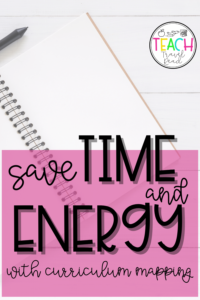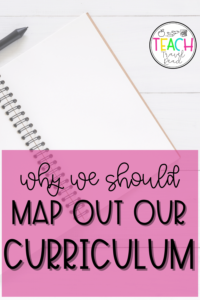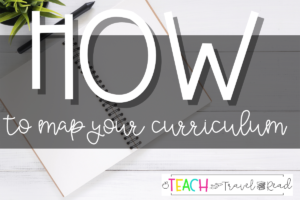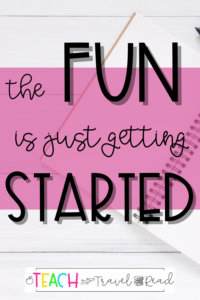Imagine this scenario…you are sitting at your teacher work area (not everyone uses a desk anymore 🙋♀️) and you open your binder or digital file to a completed curriculum map.
Ahhh…just what dreams are made of. This no longer has to be just a dream! I am a HUGE supporter of curriculum mapping in the elementary classroom. It saves us teachers so much time and energy when it’s time to plan.
In this post, we’ll take a journey into the essential steps required to develop an effective curriculum map. From determining learning goals to sequencing content, we will cover it all. Discover how to identify the key concepts and skills students need to master, create a cohesive framework for instruction, and establish a logical flow of topics in your elementary curriculum.
Organizing your curriculum in this way not only enhances student understanding and retention but also facilitates teacher planning and collaboration.
Are you ready to find out how to map out your curriculum? Grab your favorite beverage, sit back, and read on for more information.

A curriculum map is a visual representation that outlines the scope and sequence of a curriculum. It provides a structured overview of what students will learn and when they will learn it. A well-designed curriculum map identifies the key content, skills, and objectives that students need to master throughout the unit and/or school year. It also helps teachers make sure that all necessary topics and concepts are covered logically and progressively.
A curriculum map typically includes a timeline or calendar that outlines the sequence of topics or units. It may also include specific learning objectives, standards, and assessments associated with each topic. By mapping out the curriculum, educators can see the overall view of the entire learning journey and identify any gaps or redundancies in their instructional plans.
Creating a curriculum map requires careful planning and collaboration among teachers. It involves analyzing standards, identifying essential concepts, and determining the most effective instructional strategies. A well-designed curriculum map serves as a roadmap, guiding both educators and students toward successful learning outcomes.

Why do I need a curriculum map? This is a question often asked by teachers. We know what we need to teach and what resources we have available, so why map out all of the planning?
A curriculum map plays a crucial role in classrooms by providing a clear and structured framework for teaching. It ensures that teachers have a comprehensive plan in place to cover all necessary content and skills within a given timeframe. Here are some key reasons why a curriculum map is important:
Overall, a curriculum map serves as a valuable tool for elementary teachers, helping them create a well-structured and purposeful learning experience for their students. It ensures that all necessary content and skills are covered, leading to improved learning outcomes and student success.
Using a curriculum map offers numerous benefits for both teachers and students. Let’s explore some of the key advantages of implementing a curriculum map in your teaching practice:
By utilizing a curriculum map, elementary teachers can enhance student learning, improve instructional quality, and streamline their teaching practices. It provides a comprehensive framework for instruction, ensuring that all students have access to a well-structured and purposeful curriculum.

Now that you know the why, let’s talk about the how.
First question…have you ever heard of “backward planning”? It’s exactly like it sounds. You plan backward! Some people may be thinking that sounds counter-productive, but it actually is the most efficient way to plan! Start with your overall topic (big idea, essential question, learning objective, etc.) that you want to address.
The first step in creating a curriculum map is identifying the learning objectives and standards that need to be addressed. Begin by reviewing the educational standards or guidelines provided by your state or district. These standards outline the essential knowledge and skills students should learn at each grade level.
Next, break down the standards into specific learning objectives. These objectives should be clear, measurable, and achievable. Consider the essential concepts, skills, and content that students are expected to master. By clearly defining the learning objectives, you provide a clear direction for instruction.
Once you have identified the learning objectives, the next step is to sequence the content and skills in a logical order. Consider the progression of concepts and skills, ensuring that each builds upon the previous one. Start with foundational concepts and gradually introduce more complex topics.
Look at your time frame and go from there. I think about my students’ needs and how they best learn when completing my curriculum map. I break the quarter (nine weeks) into sections and choose which materials I will use when. Then I map it out and plan what to teach when.
Consider the prerequisites for each topic or unit. Ensure that students have the necessary prior knowledge and skills before moving on to the next topic. This sequential approach allows for a smooth and progressive learning experience.
Assessments and evaluations are crucial components of a curriculum map. They provide feedback on student progress and help measure the attainment of learning objectives. Integrate assessments strategically into the curriculum map, aligning them with the content and skills covered.
Consider the type of assessments that will be used, such as quizzes, projects, or exams. Determine when these assessments will be conducted and how they will be graded. This ensures that assessments are purposeful and provide meaningful feedback to both students and educators.
Once the curriculum map is created, it’s time to implement it in the classroom. Share the map with other teacherss who will be teaching the same subject or grade level. Create collaboration and communication to ensure consistency.
From there, you will then choose materials that are best suited to your topic. Depending on your district, you may or may not have materials/resources that you are already required to use. I am lucky to work in a district and position where I have flexibility in my choice and I can supplement with materials that work best for my students.
Create lesson plans based on the curriculum map, incorporating the necessary resources, materials, and instructional strategies. Consider the pacing of instruction, ensuring that each topic or unit is covered within the give timeframe.
A curriculum map is not a static document; it should be regularly monitored and adjusted based on student needs and feedback. Continuously assess student progress and evaluate the effectiveness of the curriculum map.
Do I have to make adjustments? Absolutely! Teaching is all about flexibility and sometimes plans take longer or less time than expected. Just remember to be flexible when you are scheduling the time on your curriculum map!
Gather feedback from both students and teachers and make necessary revisions to the curriculum map as needed. This ensures that the curriculum remains relevant and responsive to the changing needs of students.
By following these steps, elementary teachers can create a comprehensive curriculum map that enhances learning, organization, and success. It provides a clear roadmap for instruction, ensuring that all students have access to a well-structured and purposeful curriculum.
Let’s wrap this up! A well-designed curriculum map plays a vital role in enhancing learning, organization, and success. It provides a clear roadmap for teachers, aligning critical objectives, content, and assessment strategies. By mapping out the curriculum, elementary teachers can ensure that all students are on the same learning path, paving the way for their students’ academic achievements.
A curriculum map offers numerous benefits, including alignment with standards, consistency and coherence in instruction, effective planning and organization, collaboration and communication among teachers, and enhanced student learning outcomes. It serves as a valuable tool for elementary teachers, helping them create a well-structured and purposeful learning experience for their students.
By following the essential steps to create a curriculum map, teachers can develop a comprehensive and effective roadmap for instruction. From identifying learning objectives and standards to sequencing content, incorporating assessments, and adjusting the map based on feedback, elementary teachers can revolutionize their teaching approach and empower students with a curriculum that sets them up for success.
With a well-designed curriculum map, teachers can guide students toward exceptional learning outcomes, ensuring that all necessary content and skills are covered in a logical and progressive manner. It enhances student understanding, retention, and engagement, while also facilitating teacher planning and collaboration. Embrace the power of a curriculum map and unlock the potential for exceptional learning and success in your classroom.

I truly hope this blog post has given you some guidance on how to begin your curriculum mapping. Notice I used the word…begin. I will share more tips in the future and help you become a pro curriculum mapping teacher!
Love this journey for you!